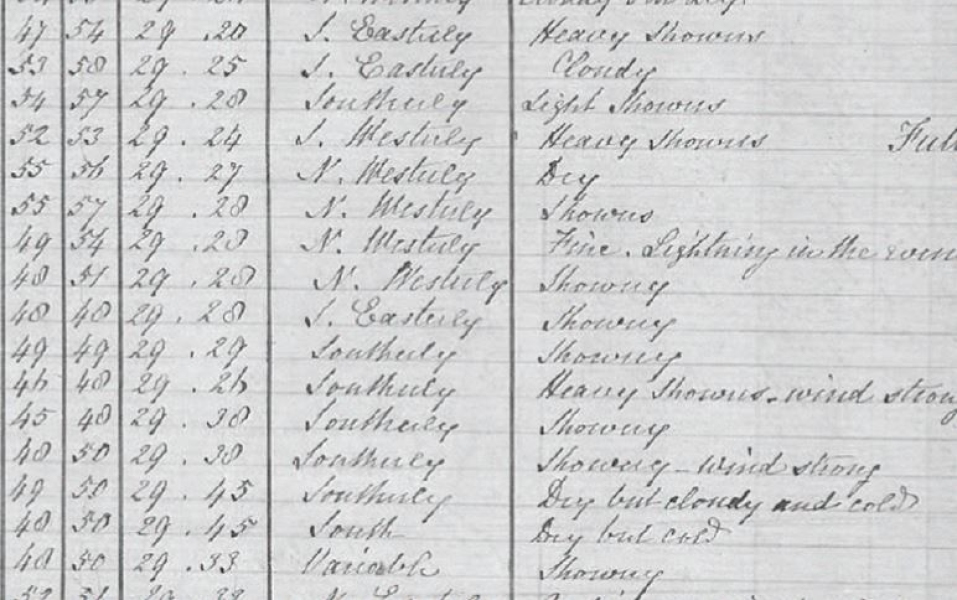NIWA climate scientists studying the diaries of an early English missionary stationed in the Far North have found the oldest surviving long-term instrumental weather records made in New Zealand.
Dr Andrew Lorrey rediscovered the diaries of Reverend Richard Davis in the Sir George Grey Special Collection in the Auckland Library as part of an international project to understand how the weather of the past affects today’s climate.
“The diaries were really hiding in plain sight,” Dr Lorrey said. “I happened to search the National Register of Archives and it came up. “
Analysis of Rev Davis’ recordings by Dr Lorrey and fellow climate scientist Petra Pearce (nee Chappell) has just been published in the international scientific journal Climate of the Past. The paper, titled The ‘dirty weather’ diaries of Reverend Richard Davis, offers insights into early colonial era meteorology and climate variability for northern New Zealand.
The diaries were donated to the library in the mid-1900s and had not been previously examined for scientific purposes. What Dr. Lorrey found was a two-volume set of meticulous meteorological records for the early settlements of Waimate North and Kaikohe covering nine years in two parts: 1839 to 1844 and 1848-1851.
Dr Lorrey and Mrs Pearce believe they could be the earliest continuous land-based meteorological measurements made in New Zealand. Their work has corroborated the data with historic ship logs from vessels anchored in the Bay of Islands at that time.
Rev Davis recorded the temperature each day at 9am and midday along with a midday pressure measurement. He also commented on wind flow, wind strength and cloud cover, and made notes about extreme weather events. The comment “dirty weather” is scattered throughout the diaries describing disturbed conditions with strong winds and driving rainfall.
Rev Davis was a key figure in the Church Mission Society, arriving at Waimate North in 1831 and established a farm. He was a prolific writer and observer of the natural environment. In his diaries he makes multiple references to frost, ice, hail falls and also mentions snow falling over two days in July, 1849.
His diary comments are as follows:
- 30 July, 1849: “Hail storms. This morning the southern hills and Poutahi covered with snow.”
- 31 July, 1849: “This morning the hills were again covered with snow.”
Dr Lorrey says despite the widely-held belief that in never snows in northern New Zealand, there are now six historic accounts of snow falling in Auckland and Northland, the latest being in 2011.
However, the diaries reveal that on average winters were colder and summers warmer during Davis’ time, which may be a result of the poor exposure of Davis’ thermometer.
“This evidence enriches our understanding that early settlers may have faced significant climate anomalies that New Zealanders continue to grapple with today.”
Dr Lorrey says the Davis diaries are expected to make a significant contribution to an international collaboration that recovers and digitises historical weather observations. The data from these records are fed into the 20th Century Reanalysis Project, which generates six-hourly snapshots of global atmospheric conditions, providing historical context and comparisons for today’s climate.
“Historic weather observations are incredibly important because they can assist our understanding of past weather and climate change.”
Regular land-based meteorological observations in New Zealand were generally regarded as having begun in the early to mid-1850s by the Royal Engineers in Auckland. However, Dr Lorrey says it is possible other historic records, such as those taken by Rev Davis, exist in private and museum collections around the country.
He would like to see Rev Davis recognised as having made some of the most significant and earliest contributions to New Zealand meteorology and climatology.
“The extent and breadth of the observations as well as their general antiquity suggest Reverend Richard Davis probably deserves the title of New Zealand’s first meteorologist.”
Rev Davis died in 1863 and is buried in the cemetery of the Waimate Mission House.
Read the paper in the Journal 'Climate of the Past'


